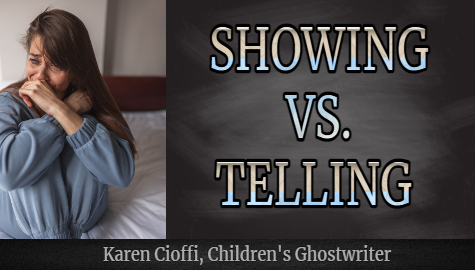Yeah, yeah, yeah . . . we’ve all heard of, or read about the showing and telling aspect of writing: you must show, not tell. But, there are those out there just beginning a writing career and may be uncertain as to the importance of this writing strategy.
While there must be some amount of exposition in your story, it should be limited. Work to keep it short and sweet. And, be sure not to use information dump.
But, what exactly does it mean to show rather than tell in your writing?
Writer’s Digest gives some of the best writing advice I’ve read on showing vs. telling. It’s by author and editor Jeff Gerke and is especially helpful to new writers, but useful to us all:
“There’s a question you can ask of any passage you feel may be telling. You ready? Get the passage in front of you and ask this of it: Can the camera see it?”
How great is that?
Now, keep in mind that ‘the camera can’t see it all. Things like tastes, smells, sounds, won’t be visible in the camera, so use your discretion with this tool.
Okay, let’s look at an example of telling:
April walked around in a daze. Her husband left her with two young children. She cried and cried. She felt awful and overwhelmed, but kept doing the things she had to do. It seemed as if her soul ached; she felt like screaming. She begged for God’s help.
Here’s an example of showing:
He wasn’t supposed to leave; we promised to stay married forever. April pulled the sheets from her bed and threw them to the floor. Doing the chores and taking care of the kids helped her hold on . . . she had to hold on. How could he leave? Tears trickled down her cheeks. She bent forward with her head in her hands. Please, God, bring him home…please…please help me. Weeping softly in her hands, her body began to tremble; then, the tears gushed. An indescribable ache took hold – in the very depths of her soul – an ache in a place never felt before. A tortured scream crept up into her throat, ready to burst forth. She fell to her knees and buried her face in the mattress. Grabbing a pillow, she pulled it over her head. A blood-curdling scream erupted.
So, that’s the difference.
I made the telling example very basic so you could easily see how they differ.
Showing lets the reader feel the protagonist’s pain, or joy, or excitement. It conveys through action and dialogue which creates a connection and prompts the reader to continue reading.
Sometimes it helps to draw from experiences to get the feeling and words you’re going for. You can also use TV and movies. Watch and study scenes that depict the experience you need to convey. Then, write what you’ve seen.
 4 Writing Tips on Using Descriptions
4 Writing Tips on Using Descriptions
The Ghostwriter
Do Book Back-Covers Really Matter?
Let me take a look at it. I’m a working children’s ghostwriter, rewriter, and coach. I can turn you story into a publishable book.
Shoot me an email at: kcioffiventrice@gmail.com (please put Children’s Writing Help in the Subject line). Or, you can give me a call at 834—347—6700



8 thoughts on “Writing – Showing vs. Telling”